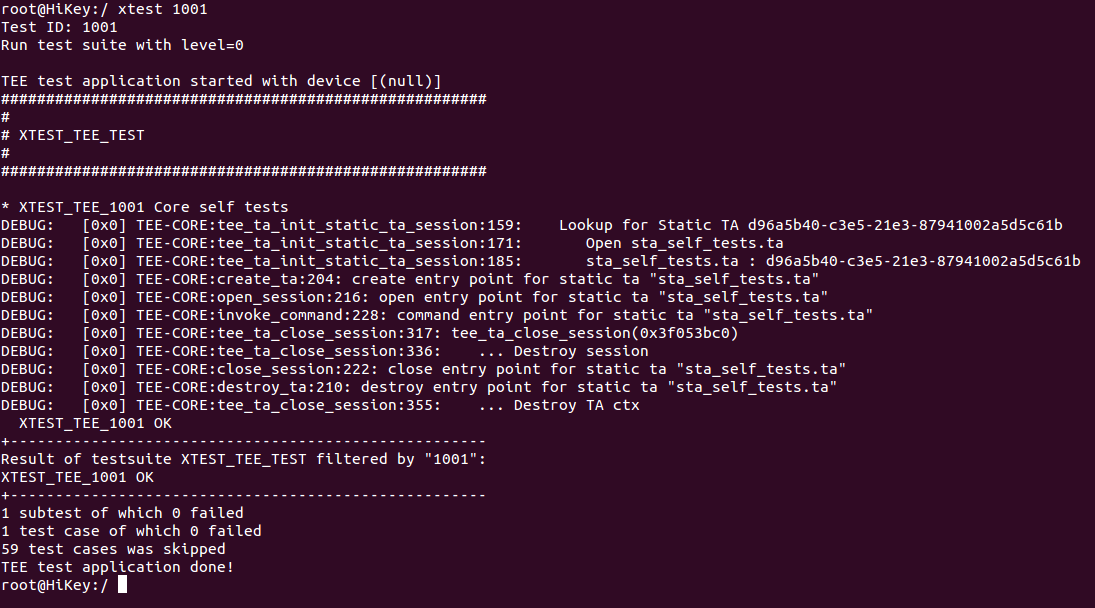- 1存内计算芯片研究进展及应用—以基于NorFlash的卷积神经网络量化及部署研究突出存内计算特性_北京大学 isscc 2022
- 2物流|基于Springboot的物流管理系统设计与实现(源码+数据库+文档)_springboot物流管理系统
- 3关于el-table中tree 懒加载默认3层及自动展开_element 表格展开懒加载
- 4最小二乘法原理
- 5confluence 内网管理网站资源_confluence 网站管理
- 6个人技术总结——Unity3D ScriptableObject实现多存档
- 7Ubuntu18.04 安装详细全过程(超多图,很少文)
- 8UniApp小程序引入iconfont字体图标(阿里巴巴矢量图标库)_uni-app小程序引入iconfont
- 9解决国内下载git慢或下载不了的问题_git客户端国内下载太慢
- 10Pygame:外星人入侵_外星人入侵 bullet
OP-TEE TA:读写寄存器数据_optee ta使用i2c
赞
踩
最近想为OP-TEE的Trusted OS开发一个触摸屏驱动,在查询代码的时候发现直接调用TA修改TZPC寄存器的值是不可行的,原因是user TA的运行采用了沙盒机制,所以无法直接访问寄存器所映射的物理地址。所以在查看了相关资料后,总结出如下方法用以解决此问题。
一. 编写static TA
在/optee_os/core/arch/arm/sta目录下新建一个sta_reg.c文件,作为一个新的static TA,具体代码如下,此文件结构参照static TA的例程程序stats.c,此文件稍微有点长,我们分段解释一下。
首先是头文件:
#include <compiler.h>
#include <stdio.h>
#include <trace.h>
#include <kernel/static_ta.h>
#include <string.h>
#include <string_ext.h>
#include <io.h> - 1
- 2
- 3
- 4
- 5
- 6
- 7
- 8
这里比较重要的是statci_ta.h和io.h,前一个头文件定义了static TA的相关函数和宏定义,后一个给出了读写寄存器物理地址中所存储的值的方法。
宏定义:
#define TA_NAME "sta_reg.ta"
#define STA_REG_UUID \
{ 0xd96a5b40, 0x12c7, 0x21af, \
{ 0x87, 0x94, 0x10, 0x02, 0xa5, 0xd5, 0xc6, 0x1b } }
#define STA_READ_STATS 0
#define STA_WRITE_STATS 1
#define CONSOLE_UART_BASE 0xF8015000
#define UART_IBRD 0x24 /* integer baud register */- 1
- 2
- 3
- 4
- 5
- 6
- 7
- 8
- 9
- 10
首先需要定义此TA的名字和对应的UUID值(此值用于user TA建立会话的时候使用),其次设置两个状态值,分别对应寄存器的读写操作,最后设置你要读取的寄存器的映射地址。(笔者这里使用的是HIKEY的UART寄存器的映射地址)
操作方法:
static TEE_Result read_regs(uint32_t type __unused, TEE_Param p[4] __unused)
{
EMSG("UART: 0x%x\n",read32(CONSOLE_UART_BASE+UART_IBRD));
return TEE_SUCCESS;
}
static TEE_Result write_regs(uint32_t type __unused, TEE_Param p[4] __unused)
{
return TEE_SUCCESS;
}- 1
- 2
- 3
- 4
- 5
- 6
- 7
- 8
- 9
- 10
- 11
读寄存器和写寄存器的相关方法实现。
其他方法:
/*
* Trusted Application Entry Points
*/
static TEE_Result create_ta(void)
{
return TEE_SUCCESS;
}
static void destroy_ta(void)
{
}
static TEE_Result open_session(uint32_t ptype __unused,
TEE_Param params[4] __unused,
void **ppsess __unused)
{
return TEE_SUCCESS;
}
static void close_session(void *psess __unused)
{
}
static TEE_Result invoke_command(void *psess __unused,
uint32_t cmd, uint32_t ptypes,
TEE_Param params[4])
{
switch (cmd) {
case STA_READ_STATS:
return read_regs(ptypes, params);
case STA_WRITE_STATS:
return write_regs(ptypes, params);
default:
break;
}
return TEE_ERROR_BAD_PARAMETERS;
}
- 1
- 2
- 3
- 4
- 5
- 6
- 7
- 8
- 9
- 10
- 11
- 12
- 13
- 14
- 15
- 16
- 17
- 18
- 19
- 20
- 21
- 22
- 23
- 24
- 25
- 26
- 27
- 28
- 29
- 30
- 31
- 32
- 33
- 34
- 35
- 36
- 37
- 38
这些方法为static TA的其他方法,由于在此功能实现中未曾用到,故都为最简实现。
static_ta_register(.uuid = STA_REG_UUID, .name = TA_NAME,
.create_entry_point = create_ta,
.destroy_entry_point = destroy_ta,
.open_session_entry_point = open_session,
.close_session_entry_point = close_session,
.invoke_command_entry_point = invoke_command);- 1
- 2
- 3
- 4
- 5
- 6
将此static TA所定义的内容提交到Trusted Core中。
最后修改/sta目录下的sub.mk文件,将新建的static TA文件sta_reg.c添加到编译序列中。
srcs-$(CFG_WITH_STATS) += stats.c
+srcs-$(CFG_WITH_STATS) += sta_reg.c- 1
- 2
二.将寄存器的映射地址添加到core_map中
修改optee_os/core/arch/arm/kernel/generic_core_bootcfg.c文件,添加一个可映射的地址,用于static TA的访问。
/* Platform-specific memory layout provided to TEE core. */
static struct map_area bootcfg_memory_map[] = {
+/* TZPC core exec */
+{
+ .type = MEM_AREA_IO_SEC,
+ .pa = 0xF8015000, .size = 0x400000,
+ .cached = true, .secure = true, .rw = true, .exec = false,
+},
/* TEE core execution RAM. */- 1
- 2
- 3
- 4
- 5
- 6
- 7
- 8
- 9
- 10
更新:OP-TEE 2.0及以上版本,使用register_phys_mem(…)控制可访问的地址空间,其中MEM_AREA_IO_NSEC参数下的地址空间,普通世界可通过STATIC TA访问,MEN_AREA_IO_SEC参数下的地址空间,只可以由安全世界访问。
笔者使用上一篇博客中提到的Helloworld.ta作为调用读写寄存器的static TA的user TA,编译和移植方法已经讲过了,不再累述。
首先在soc中运行xtest 1001检测static TA是否可用。
若运行成功结果如下图:

注意:若出现TA查找不到的错误,说明此soc中未设置static TA的相关flag,解决办法如下:
修改此soc的conf.mk文件,将未设置的flag添加进去:
endif
+CFG_TEE_CORE_EMBED_INTERNAL_TESTS ?= y
CFG_TEE_FS_KEY_MANAGER_TEST ?= y
+CFG_WITH_STACK_CANARIES ?= y
+CFG_WITH_STATS ?= y
CFG_CRYPTO_WITH_CE ?= y- 1
- 2
- 3
- 4
- 5
- 6
- 7
- 8
测试成功后,编写user TA的host部分代码,用以调用static TA,代码如下:
#include <stdio.h>
#include <err.h>
#include <tee_client_api.h>
#include <ta_hello_world.h>
#define STA_REG_UUID \
{ 0xd96a5b40, 0x12c7, 0x21af, \
{ 0x87, 0x94, 0x10, 0x02, 0xa5, 0xd5, 0xc6, 0x1b } }
int main(int argc, char *argv[])
{
TEEC_Context hello_teec_ctx;
TEEC_Result res;
TEEC_Session session = { 0 };
TEEC_UUID uuid = STA_REG_UUID;
uint32_t ret_orig;
/* Initialize a context connecting us to the TEE */
res = TEEC_InitializeContext(NULL, &hello_teec_ctx);
if (res != TEEC_SUCCESS)
errx(1, "TEEC_InitializeContext failed with code 0x%x", res);
/*
* Open a session to the "hello world" TA, the TA will print "hello
* world!" in the log when the session is created.
*/
res = TEEC_OpenSession(&hello_teec_ctx, &session, &uuid,
TEEC_LOGIN_PUBLIC, NULL, NULL, &ret_orig);
if (res != TEEC_SUCCESS)
errx(1, "TEEC_Opensession failed with code 0x%x origin 0x%x",
res, ret_orig);
/*
* Execute a function in the TA by invoking it, in this case
* we're incrementing a number.
*
* The value of command ID part and how the parameters are
* interpreted is part of the interface provided by the TA.
*/
/*
* Prepare the argument. Pass a value in the first parameter,
* the remaining three parameters are unused.
*/
printf("Invoking TA to increment !\n");
res = TEEC_InvokeCommand(&session, 0, NULL,
&ret_orig);
if (res != TEEC_SUCCESS)
errx(1, "TEEC_InvokeCommand failed with code 0x%x origin 0x%x",
res, ret_orig);
printf("test static TA\n");
/*
* We're done with the TA, close the session and
* destroy the context.
*
* The TA will print "Goodbye!" in the log when the
* session is closed.
*/
TEEC_CloseSession(&session);
TEEC_FinalizeContext(&hello_teec_ctx);
return 0;
}
- 1
- 2
- 3
- 4
- 5
- 6
- 7
- 8
- 9
- 10
- 11
- 12
- 13
- 14
- 15
- 16
- 17
- 18
- 19
- 20
- 21
- 22
- 23
- 24
- 25
- 26
- 27
- 28
- 29
- 30
- 31
- 32
- 33
- 34
- 35
- 36
- 37
- 38
- 39
- 40
- 41
- 42
- 43
- 44
- 45
- 46
- 47
- 48
- 49
- 50
- 51
- 52
- 53
- 54
- 55
- 56
- 57
- 58
- 59
- 60
- 61
- 62
- 63
- 64
- 65
- 66
- 67
- 68
最后可在soc上运行普通TA调用静态TA,将显示UART寄存器的值。


